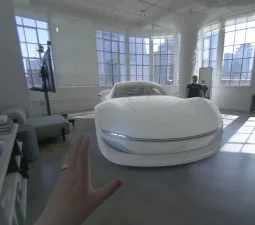As I have written before, I have been somewhat sceptical of the whole Metaverse thing (I saw a headline about a ‘Metaverse hotel’ today – how bizarre is that concept?). (Metaverse – Meta and Drink for Critics). I still have some doubts about it, but last week I did see something that was genuinely exciting – and from one of my favourite companies, Varjo of Finland.

The company gave me a pre-briefing on a press release that we have published today that set out what the firm is doing to make the experiences in its very good high end professional headset (although it also works with other headsets) shareable via the cloud in the ‘Varjo Reality Cloud’ (VRC). I’d heard about this before, but this time I got a really good demo of the system and after pushing it to one side, I have to say I was very impressed. (Varjo Wants to Develop the Metaverse and Varjo Brings World’s First Human-Eye Resolution VR/XR Cloud Streaming Capability to Its Reality Cloud Platform)
 Capture shot through Varjo XR 3 – click for higher resolution
Capture shot through Varjo XR 3 – click for higher resolution
The demonstration that I saw was via Zoom, but based on the VRC. (and as soon as I had disconnected, I realised I had forgotten to take a screengrab! Grrr….) Basically, the system uses a specially ‘ringfenced’ part of AWS, loaded up with GPUs to run, initially, Autodesk VRED and, later, Unity and Unreal engine content in the cloud. A headset such as the firm’s XR-3 pass-through device connects to the cloud and the system exploits Varjo’s foveated image capture technique to compress the signal dramatically, by focusing the detail to where it is really needed. This technique, combined with the very low latency video pipeline that I have written about before and that is part of Varjo’s ‘secret sauce’ means that visually lossless images of what is being seen by the headset can be sent back to the cloud and then distributed to other viewers. Just 35Mbps of bandwidth is needed for a ‘live’ experience and I certainly found it compelling.
What that means is that multiple viewers can take part in a virtual viewing experience, which could be a duplicate of what the person wearing the headset can see, via a Varjo or other headset, or it could be a 2D image shown on a PC or mobile device or, as it was in the demo that I saw, a zoom call with multiple windows showing the headset view, the ‘real world’ view of the environment and the participants in the call.
To get the feeling of really ‘being there’ needs really low latency and tight, tight integration, so Varjo likes to control the whole platform. The firm told us that when it used a shared AWS system, even with high GPU power, there were periods when relatively heavy loading meant a loss of performance. So the decision was made to use a ‘ringfenced’ but still scalable AWS configuration and to offer the technology as a complete service at $1500 for a team of five. This has the advantage for users of moving the payment from being capex to opex. Varjo also highlighted that controlling the whole system means that it can ensure enterprise level security systems.
The key initial market is in the automotive segment for vehicle design (and the firm shared an endorsement video with Volvo). As you can imagine, being able to share a highly realistic virtual model of a new vehicle and simply change the colour or map the vehicle into a new virtual environment (with realistic reflections and lighting) across the globe is really powerful. Because the system also allows the connection of 2D viewing devices, it is also great to have the possibility of connecting those without headsets and technology into the session. You can see a video of a vehicle here.
I also can imagine great interest from other applications such as architectural walkthroughs. I mentioned to Varjo the very interesting opportunities in virtual TV and movie production, although they didn’t seem convinced that ‘there’s a busines model for Varjo’. To me, the opportunity is that in virtual productions, a lot of the work that would have previously been done in post-production has to be done ‘up-front’ and before the capture. I could absolutely see content creators and producers being very interested in being able to share high resolution and high quality 3D imagery of the virtual sets between technicians, but also with other less technical staff that still want to contribute. There’s a video of ‘life-size’ avatars in mixed reality here.
By chance, on Tuesday of this week, I was able to spend some time at the IT2EC event in London which is all about military training and simulation*. Varjo was one of the exhibitors along with a partner. I was finally able to get a chance to try the Aero headset on a high end PC running Microsoft’s Flight Simulator and I can now see why this is a compelling application for the headset as the resolution and clarity of the headset is good enough to give a realistic view, but also allow the details of instruments etc. to be read. I suspect that there are also plenty of military and simulation applications that could benefit from the Varjo Reality Cloud. (BR)
*I’m planning a DD on that visit shortly.
This article was independently produced by Display Daily, but was moved outside the paywall by Varjo, thanks to them. It will not count as one of your free articles in a month.

